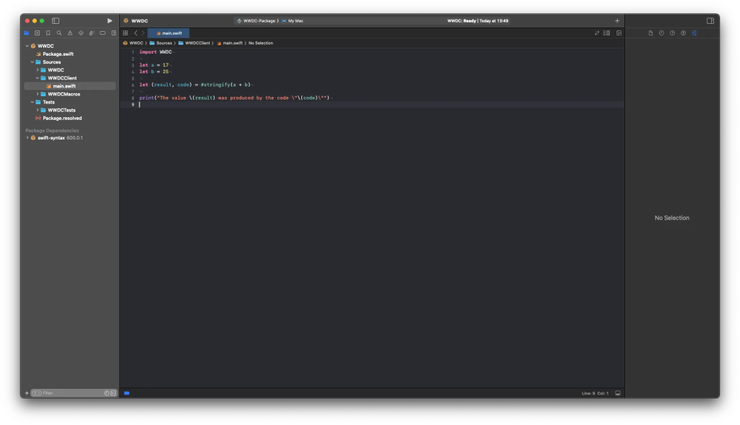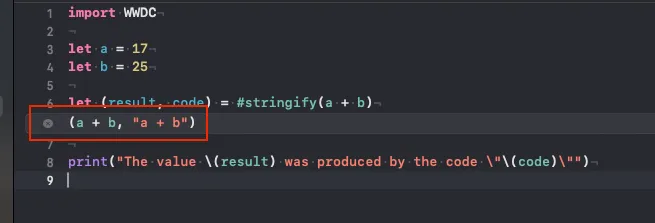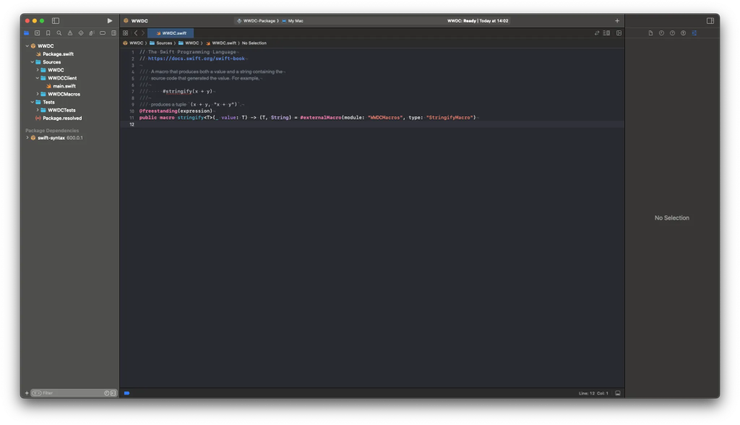
New Zealand - Deer Park Heights Queenstown
觀看 WWDC23 Write Swift macros 筆記
Overview
Apple 一開始提出一個範例,把計算的過程顯示成字串,用一個 tuple 組合起來,但這種方式很明顯,有個大缺點,就是容易有人為疏失,導致錯誤發生,還無法用 compiler 檢查字串是否相等於左邊的算數。

但在 Swift 5.9 中,我們可以定義一個 stringify 的 macro 來簡化這過程,這個 macro 也在 Xcode 的模板中。

我們來單獨看一下這個 macro 的定義

它很像一個普通 function,可以接受一個整數作為輸入參數,並輸出一個 tuple 結果。
像我們這樣定義型別都很清楚,就可以使用的很安心。

Swift 與 C 語言的 macro 不同,C 語言的會在型別檢查之前的預處理器階段進行評估。
Swift 的都是用我們熟悉的的函數功能,例如可以讓 macro 變成 generic 的。
要注意的是,這個 macro 使用 @fresstanding 的表達式角色聲明的,這表示開發者可以在任何可以使用表達式的地方使用這個 macro,並且將以井字號標示,就像 #stringify 。

還有另外一種 macro,是可以增強聲明的 attached macro,稍後會再詳細介紹。
Macro plug-in
再來讓我們瞭解其工作原理,先把重點關注在 freestanding 的 macro,每個 macro 的執行就是會把程式碼 expansion(展開),過程會先在 compiler plug-in 中定義如何實現,然後 compiler 會將整個 macro expression(表達式)的原始碼發送到這個 plug-in。
那這個 plug-in 要做的第一件事,就是將 macro 的源程式碼解析為 SwiftSyntax tree,而這個 tree 是 macro 的原程式碼,精確的結構表示,這就是執行 macro 的基礎。

像裡面有 identifier 就是該 macro expression 的名稱 stringify 。
而 Swift macro 強大的地方在於, macro 的實現本身就是一個用 Swift 編寫的程式,可以對 syntax tree (語法樹)進行任何轉換。
在這個範例,它生成了我們之前看到的 tuple,把生成的 syntax tree 序列化為原始碼,並將其發送給 compiler,然後會用 expansion (展開)的程式碼替換為 macro experssion(表達式)圖片的右上角 (2 + 3, "2 + 3")。

Create a marco
我這邊使用的是 Xcode 16.2
打開 Xcode → File → New → Package

選擇 Swift Macro 的模板


最後在自行命名,這邊我使用 WWDC,和影片一樣,然後我們打開 WWDCClient 資料夾的 main.swift

可以對這個 macro 按右鍵 Expand Macro


這跟之前看到的結果一樣
再來我們可以看他是如何定義的,一樣右鍵 Jump to Definition

跟之前介紹的稍微不太一樣,這邊使用 generic 的方式,接收任何型別的 T。
他是被宣告成 #externalMacro ,這告訴 compiler 在執行展開時,它需要查看 WWDCMacros module 中的 StringifyMacro 類型。
那這個類型是如何定義的?我們可以用快速開啟的方式,查找它



因為 stringify 是一個 freestanding 的 expression macro ,所以在這我們可以看到 StringifyMacro 是要遵守 ExpressionMacro protocol,這個 protocol 有一個要求就是實作 expansion(of:in:) 。

of node: **some** FreestandingMacroExpansionSyntax語法樹參數in context: **some** MacroExpansionContext用於與 compiler 溝通上下文的參數ExprSyntax重寫的表達式語法
那麼在實現中都做什麼?

首先,檢索 macro 表達式的單個參數,這個參數一定存在,因為 stringify 被設計接受單個參數傳入,並且在 macro 展開之前,所有參數都要進行型別檢查。
最後在 return 時,使用 string 插值來建立 tuple 的語法樹,return "(\\(argument), \\(literal: argument.description))" ,第一個元素 (argument )是參數本身,第二個元素 (argument.description) 是一個包含參數原始碼的文字。
但要注意的是,在這裡並不是返回我們平常使用的 String,這是返回一個 expression syntax 表達式語法,這個 macro 將自動調用 Swift 解析器,將這個 literal 文字轉換成語法樹。
再來我們需要講講測試,我們的專案裡已經有這個測試檔案了

這邊的測試會使用 assertMacroExpansion function,來驗證 stringify macro 是否正確展開。

Swift macro template
- Macro declaration defines the macro’s signature
我們在其中看到了基本編譯分塊,會有不同的 module 不同的 type,還有 macro role。
- Implementation operates on SwiftSyntax trees
Compiler 插件執行展開操作,它本身是一個用 Swift 編寫的程式,並且在 SwiftSyntax 上執行。
- Easy to test
我們還看到他非常容易進行測試,因為它們是語法樹的確定性轉換,而且語法樹的原始碼很容易比較。
Macro roles

簡單說明一下
@freestanding 使用 # 開頭
@attached 使用 @ 開頭
其他細節可參考 WWDC23 Expand on Swift macros
但這邊特別介紹一下 @attached(member) ,下面是一個滑雪相關 app,會讓初學者找到適合的坡道

我們定義了一個通用的 enum Slope ,包含所有坡道,簡單到困難的,另外還有一個只有簡單坡道的 enum EasySlope ,雖然這樣很好提供了型別安全性,但很重複,像是如果想要再新增一個簡單的坡道,就要動到這兩個 enum,還有其中的 initialization 及 computed property。
我們來試試看使用 macro 來改進此情況,目標是自動生成 initialization 及 computed property。
The Plan
- Declare attached member macro
- Create empty macro implementation
- Create test case
- Write macro implementation
- Integrate macro into app
接著我們用剛剛的專案來改,可以把 stringify 相關的東西給刪除。
我們先在 WWDC.swift 的檔案定義 attached member macro。
/// Defines a subset of the `Slope` enum
///
/// Generates two members:
/// - An initializer that converts a `Slope` to this type if the slope is
/// declared in this subset, otherwise returns `nil`
/// - A computed property `slope` to convert this type to a `Slope`
///
/// - Important: All enum cases declared in this macro must also exist in the
/// `Slope` enum.
@attached(member, names: named(init))
public macro SlopeSubset() = #externalMacro(module: "WWDCMacros", type: "SlopeSubsetMacro")
再來我們到 WWDCMacro.swift 的檔案定義 SlopeSubsetMacro,我們這邊刻意先讓他返回一個空陣列,因為我們要先來寫測試。
/// Implementation of the `SlopeSubset` macro.
public struct SlopeSubsetMacro: MemberMacro {
public static func expansion(
of attribute: AttributeSyntax,
providingMembersOf declaration: some DeclGroupSyntax,
in context: some MacroExpansionContext
) throws -> [DeclSyntax] {
return []
}
}
可是我們需要讓 SlopeSubset 在 compiler 中可見,所以還要新增
@main
struct WWDCPlugin: CompilerPlugin {
let providingMacros: [Macro.Type] = [
SlopeSubsetMacro.self
]
}
再來回到 WWDCTests.swift 的檔案,開始新增測試
let testMacros: [String: Macro.Type] = [
"SlopeSubset" : SlopeSubsetMacro.self,
]
final class WWDCTests: XCTestCase {
func testSlopeSubset() {
assertMacroExpansion(
"""
@SlopeSubset
enum EasySlope {
case beginnersParadise
case practiceRun
}
""",
expandedSource: """
enum EasySlope {
case beginnersParadise
case practiceRun
}
""",
macros: testMacros
)
}
}
我們的 macro 什麼都沒有做,先測試是否可以執行,以上面的程式碼測試結果,是會通過。
接下來我們把預期的結果給貼上去,最後會變成這樣
let testMacros: [String: Macro.Type] = [
"SlopeSubset" : SlopeSubsetMacro.self,
]
final class WWDCTests: XCTestCase {
func testSlopeSubset() {
assertMacroExpansion(
"""
@SlopeSubset
enum EasySlope {
case beginnersParadise
case practiceRun
}
""",
expandedSource: """
enum EasySlope {
case beginnersParadise
case practiceRun
init?(_ slope: Slope) {
switch slope {
case .beginnersParadise:
self = .beginnersParadise
case .practiceRun:
self = .practiceRun
default:
return nil
}
}
}
""",
macros: testMacros
)
}
}
在執行一次測試,是失敗的,很合理,因為我們還沒有實作 macro 的 init。

接下來我們回到 WWDCMacro.swift 開始實作
我們先確定我們使用 macro 的人,是不是 enum
import SwiftCompilerPlugin
import SwiftSyntax
import SwiftSyntaxBuilder
import SwiftSyntaxMacros
/// Implementation of the `SlopeSubset` macro.
public struct SlopeSubsetMacro: MemberMacro {
public static func expansion(
of attribute: AttributeSyntax,
providingMembersOf declaration: some DeclGroupSyntax,
in context: some MacroExpansionContext
) throws -> [DeclSyntax] {
guard let enumDecl = declaration.as(EnumDeclSyntax.self) else {
// TODO: Emit an error here
return []
}
return []
}
}
@main
struct WWDCPlugin: CompilerPlugin {
let providingMacros: [Macro.Type] = [
SlopeSubsetMacro.self
]
}
再來我們需要獲取 enum 聲明的所有元素,在此之前我們可以檢查 SwiftSyntax 樹中,enum 的語法結構,由於 macro 的實現只是一個普通的 Swift 程式,我們可以用 Xcode 中所有熟悉的工具,例如我們可以在展開函數內設置斷點,並執行測試時觸發該斷點

我們可以在 Debug console 那輸入 po enumDecl ,讓我們檢查一下輸出

接下來我們來看看這語法樹的內容,最裡面的節點是 enum 元素,就是 beginnersParadise 及 practiceRun 。

為了獲取它們,需要按照語法樹中給出的結構進行操作,所以讓我們逐步瀏覽該結構,並在過程中編寫訪問的 code。
在 enum 的聲明中有一個名為 memberBlock 的子級,該子級裡有一個 leftBrace ,它代表左右括弧,所以最底下還有一個 rightBrace,再來是一個 members ,因此要訪問 member 的話,要先從 enumDecl.memberBlock.members開始,所以 code 就是
let members = enumDecl.memberBlock.members
let caseDecls = members.compactMap { $0.decl.as(EnumCaseDeclSyntax.self) }
let elements = caseDecls.flatMap { $0.elements }
這樣我們就可以拿到 enum 的所有 case ,再來就是自動生成 initialization

我們關鍵要處理的就是一個 switch case,所以我們需要處理這些 case,然後創建語法節點,要查找創建語法節點有兩個好方法,除了剛剛用 po 的方式,過來就是閱讀 SwiftSyntax 的文件。
我們先建立一個 InitializerDeclSyntax,其實有點像我們平常寫 code 一樣,只是關鍵在我們要用一堆 Syntax 包裝
let initializer = try InitializerDeclSyntax("init?(_ slope: Slope)") {
try SwitchExprSyntax("switch slope") {
for element in elements {
SwitchCaseSyntax(
"""
case .\\(element.name):
self = .\\(element.name)
"""
)
}
SwitchCaseSyntax("default: return nil")
}
}
所以最後會變成
/// Implementation of the `SlopeSubset` macro.
public struct SlopeSubsetMacro: MemberMacro {
public static func expansion(
of attribute: AttributeSyntax,
providingMembersOf declaration: some DeclGroupSyntax,
in context: some MacroExpansionContext
) throws -> [DeclSyntax] {
guard let enumDecl = declaration.as(EnumDeclSyntax.self) else {
// TODO: Emit an error here
return []
}
let members = enumDecl.memberBlock.members
let caseDecls = members.compactMap {
$0.decl.as(EnumCaseDeclSyntax.self)
}
let elements = caseDecls.flatMap { $0.elements }
let initializer = try InitializerDeclSyntax("init?(_ slope: Slope)") {
try SwitchExprSyntax("switch slope") {
for element in elements {
SwitchCaseSyntax(
"""
case .\\(element.name):
self = .\\(element.name)
"""
)
}
SwitchCaseSyntax("default: return nil")
}
}
return [DeclSyntax(initializer)]
}
}
接下來可以執行測試看看,看看我們是否有寫正確,讓他能成功初始化,沒意外照著做,到這邊應該是會成功。
再來我們要再開一個新專案測試,導入我們寫好的這個 macro,但注意這邊要先關閉掉原本 macro 的專案,然後再要測試 macro 的專案導入,沒有關閉的話會導入後不能使用。
開新專案後,這邊專案命名我用 TestMacro,然後到 Package Dependencies,按下加號

點選 Add Local…,選擇剛剛做的 WWDC macro 資料夾,然後加入


再來找個新增檔案 Slope.swift ,然後貼上下面程式碼,這是主要要測試的內容
import WWDC
enum Slope {
case beginnersParadise
case practiceRun
case livingRoom
case olympicRun
case blackBeauty
}
enum EasySlope {
case beginnersParadise
case practiceRun
init?(_ slope: Slope) {
switch slope {
case .beginnersParadise: self = .beginnersParadise
case .practiceRun: self = .practiceRun
default: return nil
}
}
var slope: Slope {
switch self {
case .beginnersParadise: return .beginnersParadise
case .practiceRun: return .practiceRun
}
}
}
首先我們在 EasySlope 中加上我們剛剛寫的 @SlopeSubset 然後 build code

這時 EasySlope 就出現一個錯誤,因為我們在 @SlopeSubset 已經做了重複的事情,只要移除掉 24 行的 init?(_:) 就解決了。
之後假如我們想要看這個 macro 做了什麼,只要右鍵它,並點選 Expand Macro 就可以了。


假如還想要知道更多細節,用 option 按鈕,點擊它

Write Macro
透過使用 macro,能夠在不編寫重複的程式碼下,獲得 EasySlopes 的型別安全性
- Start with Swift macro package template
- Use debugger to explore syntax node structure
- Develop macro based on test cases
- Add package to an Xcode project
Diagnostics
假如發生在不支援的情況下,使用 macro 會發生什麼事?這時就需要發出一些錯誤訊息,告訴使用者發生什麼狀況。
像是我們寫的 SlopeSubset 只能用在 enum,假如用在 class 或 struct 上面就要報錯,並讓使用者發生什麼錯誤,所以我回去把原本的 TODO 補起來吧。
首先我們先寫一個 test case,把下面的 code 加到 WWDCTests
func testSlopeSubsetOnStruct() throws {
assertMacroExpansion(
"""
@SlopeSubset
struct Skier {
}
""",
expandedSource: """
struct Skier {
}
""",
diagnostics: [
DiagnosticSpec(message: "@SlopeSubset can only be applied to an enum", line: 1, column: 1)
],
macros: testMacros
)
}
仔細看,我們這邊刻意讓 macro 使用在 struct 上面,所以我們不期望它會生成一個初始化,而且應該要發出一個 diagnostics,也就是一個錯誤,所以上面的程式碼執行測試後,應該會得到一個錯誤,因為我們還沒有修改那個 TODO,讓它輸出錯誤,接下來就是來調整一下,我們回到 WWDCMacro.swift
我們可以定義一個 enum Error,如下
enum SlopeSubsetError: CustomStringConvertible, Error {
case onlyApplicableToEnum
var description: String {
switch self {
case .onlyApplicableToEnum: return "@SlopeSubset can only be applied to an enum"
}
}
}
然後在 guard else 的 TODO 地方改成 throw SlopeSubsetError.onlyApplicableToEnum

然後我們再重新執行一次測試,這次應該要通過,而且假如我們真的把 @SlopeSubset 加在 struct 上,馬上會得到 Xcode 的錯誤

接下來我們來優化這個 macro,讓它更通用
我們先打開 WWDC.swift,定義 macro 的地方,原本是這樣
@attached(member, names: named(init))
public macro SlopeSubset() = #externalMacro(module: "WWDCMacros", type: "SlopeSubsetMacro")
我們可以加入 generic 的方式,所以定義一個 <Supertset> ,而且他不是專屬 Slope 了,可以取一個通用一點的名稱,叫 EnumSubset,可以用右鍵點擊 SlopeSubset 然後 Refactor 和 Rename

再來就是要改內容了,要讓他能使用 generic 的東西,做法可以跟之前一樣,設定斷點,然後查看 syntax tree 的節點,取得 generic 參數,code 如下,放在 guard let enumDecl 之後, let members 之前。
guard let supersetType = attribute
.attributeName.as(IdentifierTypeSyntax.self)?
.genericArgumentClause?
.arguments.first?
.argument else {
// TODO: Handle error
return []
}
然後把 let initializer 那句做調整
let initializer = try InitializerDeclSyntax("init?(_ slope: \\(supersetType))") {
雖然還很多細節沒調整完,例如文件註解,但我們可以先測試一下 test case 是否正常,所以回到測試,因為我們改成 generic 的,所以寫法要改成 @EnumSubset<Slope> ,沒出狀況的話,這邊是要測試能通過的。
Summary
- Start with macro package template
要建立 macro 可以從 macro template 開始,裡面還有一個 stringify macro,是一個好範例。
- Write test cases
在開發 macro 的時候,強烈建議寫測試
- Print syntax tree in debugger
善用斷點,在 expansion function 中打印 syntax tree, 會更知道怎麼寫 code
- Write custom error messages
也要多寫 error message,假如遇到 macro 不適用的情況





















